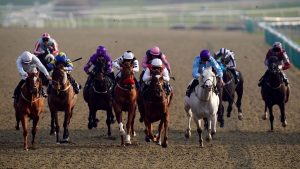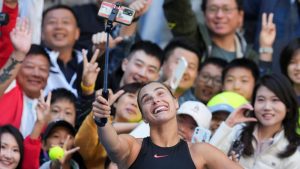How Evan Phillips became the Dodgers’ ‘High Leverage Honey Bun’


By Rowan Kavner
FOX Sports MLB Writer
Dodgers reliever Evan Phillips’ circuitous path to earning the nickname “High Leverage Honey Bun” began in earnest during his first month on campus at the University of North Carolina Wilmington.
Phillips, now the most trusted reliever on the top pitching staff in the majors, was, before his 2013 college baseball season, just a hungry freshman preparing to go over a game chart at a fall scrimmage. He knew he wouldn’t pitch that day, so he brought a snack with him behind home plate.
The nickname stuck.
“To this day, my fantasy football league with my college friends, anybody from that time of my life, it’s always ‘Honey Bun’ or ‘Bun,'” he said.
It’s one thing for his old college buddies to call him that. It’s another for pitchers on a playoff roster to do the same.
But Alex Vesia couldn’t resist.
A team’s relievers are often a close-knit group, a family within a family. Spending hours together every day in a bullpen forges relationships and bonds, particularly by season’s end. For the Dodgers, video games have helped bring the relievers even closer.
Vesia found out about Phillips’ nickname through his Call of Duty gamertag.
“He had added me the first time we played,” Vesia said. “I thought it was the best name ever.”
“I get the same response from everybody,” Phillips interjected. “Who the hell is ‘Honey Bun’?”
*** *** ***
Late last month, with the Dodgers in New York City to face the Mets, Phillips was with his wife, Elizabeth, getting a bagel and a cup of coffee for breakfast when he was approached by a man in line.
“Hey, are you Evan Phillips?”
Phillips thanked the stranger for saying hello, still surprised anyone would recognize him, especially among a team full of superstars.
“I think I’m a pretty stock, generic white guy,” the 6-foot-2-inch, clean-shaven reliever said.
He also happens to be the best healthy reliever on the best team in baseball, the star of a Dodgers bullpen that holds the lowest ERA in the National League despite a litany of significant absences.
Phillips is worth more wins above replacement than any other Dodgers reliever this year. The journeyman 28-year-old holds the top ERA (1.22) and WHIP (0.75) among all qualified NL relievers. With Blake Treinen and Daniel Hudson both out for much of the season, Phillips has stepped in as the fireman, the player the Dodgers turn to with the game in the balance.
In fact, nearly half (44.8%) of his appearances have come with the tying run at the plate, the tying run on base, the go-ahead run at the plate or the go-ahead run on base. Opponents have a .174 batting average against him in those scenarios.
He has thrown the most high-leverage innings of any Dodgers pitcher, and he boasts the highest win probability added of all Dodgers relievers. He can be deployed with confidence against lefties (.161/.226/.215, 0.75 WHIP) and righties (.135/.209/.202, 0.74 WHIP).
Of the 22 runners Phillips has inherited this season, only five have scored. That 23% mark is the best among Dodgers relievers who’ve inherited at least 10 runners this year.
“He throws strikes, gets ahead, works quick,” Dodgers manager Dave Roberts said. “There’s a lot to like.”
It was not always that way. The occasional public recognition, now occurring more than ever, is a result of Phillips’ play.
This season, he is solidifying his place as a major-leaguer on the opposite coast from where his baseball dreams began. He was born in Maryland and grew up in North Carolina. He displayed enough promise at UNC Wilmington to be drafted by the Braves in the 17th round in 2015, though he was a considerably different prospect than the high-leverage weapon he has become.
Through college and the minor leagues, Phillips was predominantly a fastball pitcher.
“I had a breaking ball,” he said. “At that time, it was in between a hard slider and cutter, and I was also mixing in a pretty bad curveball. As the velocity on my fastball increased, the hard slider pretty much became irrelevant.”
Phillips was still figuring out who he was as a pitcher when he made his major-league debut on July 3, 2018. He allowed six runs in his first two outings and made four July appearances before being traded to the Orioles as part of the package that sent Kevin Gausman to the Braves. For Phillips, it felt like a dream to go to Baltimore, the team he had cheered for all his life.
Exactly one month after his MLB debut, Phillips made his Orioles debut on Aug. 3 against the Rangers, becoming the 26th player born in Maryland to appear in an Orioles game. He struck out three batters in two scoreless innings.
But the fairytale ended quickly.
Phillips walked three batters his next time out, then allowed four runs in each of his next two outings before getting optioned. The struggles made it difficult for him to savor his time with his hometown team. He was recalled again in September but allowed three more runs in his only appearance the rest of the year.
“I wouldn’t be shy to say I probably wasn’t ready for the major leagues in 2018,” Phillips said. “I didn’t really have a secondary pitch. I had a mediocre fastball at mid-90s velocity, which is pretty generic in the major leagues now. I felt like I was pitching with my back up against the wall already, and that’s really not an advantageous way to start out a major-league career.”
Phillips spent the next two seasons bouncing between the Orioles’ major-league club and Triple-A Norfolk. By then, his curveball was a relic of the past. In late 2019, he began to alter the grip on his slider in an attempt to create more sweeping action. But he had a tendency to get around the pitch, trying to do too much to get it to move and causing an inconsistent release point.
He had a 6.43 ERA and 1.86 WHIP in 25 appearances with the Orioles in 2019. The next year (5.02 ERA, 1.67 WHIP) wasn’t much better. Still, he began to use his slider more. Endless repetitions, trial and error, and a search for the right feel created a more consistent movement profile. But the command still wasn’t there.
In August 2021, while pitching at Triple-A Norfolk, Phillips was released. He signed with the Rays on a minor-league deal two days later and made two appearances for Triple-A Durham before getting called up. In his lone appearance for Tampa Bay, Phillips earned a three-out save in a blowout win. Then he was designated for assignment.
His pitch mix, particularly Phillips’ sweeper, intrigued the Dodgers enough for them to give him an opportunity. Dodgers assistant pitching coach Connor McGuiness noted Phillips’ intelligence and inquisitive nature immediately.
“He’d just be picking everyone’s brain: ‘How are you throwing this? How do I get out a righty? Or a lefty? If my fastball’s doing this, how can we optimize?’ This, that and the other,” McGuiness recalled. “He’s one of the best self-coaches I’ve ever been around.”
Phillips made seven appearances for the big-league club in 2021, finishing four of those games and posting a 3.48 ERA. He didn’t make the roster for the wild-card game or division series, but that time allowed him to soak in the playoff atmosphere without feeling overwhelmed.
His opportunity would come. The Dodgers put him on the roster for the NLCS against the Braves. With L.A. nursing a three-run lead, he held Atlanta scoreless in 1⅔ innings in a Game 3 victory. In Game 5, Phillips retired all four Braves batters he faced, including three by strikeout in a blowout win.
By then, Phillips had started to gain more confidence in his slider, incorporating it nearly as often as his four-seamer. The Dodgers had suggestions for him, but they didn’t want to throw too much at him late in the year.
“When you get a guy at that point in the season, you want him to go out and perform because he’s fighting for a job,” McGuiness said. “The last thing you want to do, right when you get him, [is] ‘Hey, let’s do this, this, this and this,’ and it doesn’t go well for him, and that’s unfortunate. A lot of times we get guys, we want them to be them and go do their thing. We’ll add small, little suggestions along the way.”
Spring training this year allowed the Dodgers to more fully expand and fine-tune Phillips’ repertoire.
“It was pretty early on we knew we had something special,” McGuiness said. “Bullpen coach Josh Bard, he was really in love with him. I think it’s just a testament to Evan that he took the info, soaked it in and kind of made it his own. It’s been awesome to see what he’s been doing.”
The Dodgers laid out a plan for Phillips. In the simplest terms, they wanted him to throw his best pitches more often. They told him he’d be throwing his slider more, so he needed to learn how to command it both in and out of the zone while maintaining the break that makes it so distinctive.
This year, his slider is getting nearly nine more inches of horizontal break compared to sliders thrown at similar velocity, release point and extension. He’s getting that movement while throwing first-pitch strikes a career-best 68.7% of the time and posting the highest strikeout rate (31.1%) and lowest walk rate (6.6%) of his career.
“We kind of just challenged him to challenge himself a little more,” McGuiness said.
In years past, Phillips’ sliders were volatile. Some would feature enormous break; others wouldn’t. Some would drop; others would stay up. Too often, he was trying to manipulate the pitch, attempting to create the sweep he wanted. In Los Angeles, Phillips has gained a better understanding of how and why the pitch works.
It all began to click for him earlier this year in Minnesota, where he came up with a physical cue to help him stay behind the ball.
“If you talk to every single pitcher, they would tell you they have a physical feeling, maybe with their legs, maybe with their upper body, whatever it may be,” Phillips said. “Mine was to try to keep my arm as close to my head and my ear as possible. My feeling is trying to smack my ear with my hand as I’m coming through, that way I know I’m right behind the ball.”
A consistent release point bred consistent production. The shape, velocity and movement of his slider started to repeat.
Phillips threw 1⅓ scoreless innings against the Twins on April 12 — his first of seven straight scoreless outings. Soon, his sixth-inning opportunities became eighth-inning opportunities as he began to establish himself as a legitimate late-inning threat.
After a standout first half, he has performed even better after the All-Star break, with a 0.78 ERA and 0.70 WHIP in the season’s second half. On the season, opponents are batting .159 with 36 strikeouts against his slider, a pitch he’s throwing more than 44% of the time.
“It’s finally at the point now where I feel like it’s the best breaking ball I’ve ever had,” Phillips said.
But he couldn’t get to this point with one pitch alone.
Phillips also redefined his pitch mix this spring, adding a cutter to combat left-handers, one that varies considerably from the cutter he threw in the minors. Lefties haven’t homered off him this year, and they’re batting .161 against his cutter.
“This one is borderline as close to a fastball as you can get,” Phillips said. “It’s no Kenley Jansen cutter, but the effect it has on the hitter in relation to what they’re expecting has been really the big difference-maker.”
The adjustments continued.
While the cutter neutralized lefties, Phillips wanted another weapon to thwart righties. McGuiness helped him toy with grips on a sinker. Phillips had thrown the pitch earlier in his career, but he said it “went to the wayside.” He started throwing it again this summer, adding another weapon to play off his slider and four-seamer. Now righties are batting .083 against his sinker.
“Adding that in about halfway through the season really wasn’t too discomforting for me,” Phillips said. “That one’s been really, really just a relief to have, something I can throw inside on a righties’ hands. It’s really opened a lot more not only with sliders away but four-seams away, four-seams up. It’s really just another whole different section of the tool belt, you could say, when it comes to my attack plan for hitters.”
Opponents are hitting .147 against Phillips overall and worse than .165 against all four pitches in his arsenal. He is maintaining his consistency, serving as the rock of the Dodgers’ bullpen. And as thrilled as he is to be performing this way, he’s just as elated to share the success with his family.
From the other side of the country and the early morning hours on the East Coast, Phillips still receives a text from his father after games. The Orioles will always be Phillips’ hometown team, but he has found a home with his L.A. team.
“I appreciate my time there,” Phillips said of Baltimore, “because it got me to this point.”
*** *** ***
The Dodgers demoted Craig Kimbrel as closer on Friday and will turn to a committee in the ninth for the foreseeable future.
Phillips could be part of that mix, but the highest-pressure moments — the spots where one pitch can change a game — often occur before the ninth inning. For that reason, the Dodgers might choose to keep Phillips in his current role, extinguishing the most daunting threats.
He is holding opponents to a .178 batting average with runners in scoring position and has pitched a team-high 20 times in “late/close” situations — in the seventh inning or later, with the batting team leading by a run, tied or with the tying run on base, at-bat or on-deck — while limiting opponents to a .156 average in those spots.
Phillips’ success has spawned a new nickname, courtesy of Bard’s son: “High Leverage Honey Bun.”
Vesia loved the name so much that he enlisted the graphic design help of one of his best friends, a former Cal State East Bay teammate and independent ball player, Andrew Fernandez, for the project.
“I called him and said, ‘I have the best shirt idea,’” Vesia said.
One week ago, “High Leverage Honey Bun” T-shirts made their way to the Dodgers clubhouse. They’re a lasting symbol of a pitcher who has finally cemented his place.
“To be with this team is incredible in itself, but to be an integral piece of that hadn’t really dawned on me yet,” Phillips said. “When we clinched the division last week, it really felt good to have that success and feel that success across a full season with the team. I did kind of savor the fact that I recognized that I’ve been a piece of that. That felt really nice.”
Rowan Kavner covers the Dodgers and NL West for FOX Sports. He previously was the Dodgers’ editor of digital and print publications. Follow him on Twitter at @RowanKavner.
Get more from Major League Baseball Follow your favorites to get information about games, news and more.






